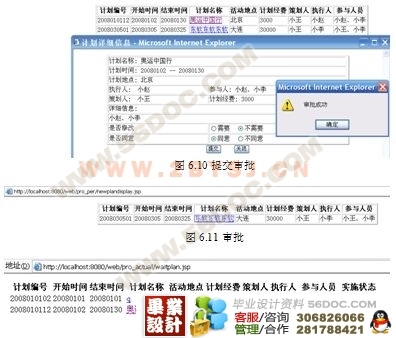摘 要
近年来,网络技术高速发展,网络基础设施也越来越完备。基于B/S架构的“电信企业CRM系统市场推广管理的设计与实现”系统是为了用户可以随时掌握市场推广情况、获取最新的各方面信息而开发出来的。对于这个庞大的系统,我制作了其中的几个基本组成部分。
本文的第一章描述了网络的发展状况,引出自行开发该系统的目的和意义,并提出系统要使用的开发技术。第二章阐述用户对电信企业CRM系统市场推广管理的设计与实现的功能需求。针对用户需求,第三章概括性的介绍了系统主要功能和用户区别。第四章图文并茂详述了系统的具体功能的实现过程,并对开发技术、软硬件要求及数据库的设计做了确切的说明。最后,文章对系统开发的全过程进行总结并对系统的前景做出了展望。
文中的理论论述和编码方式都是采用当今最流行的J2EE技术为平台。其中,作为程序实际代码开发所需的JSP、JAVABean等方法的原理和应用,在文中都做了详细的阐述。系统使用的MySQL数据库的特点及数据库的建立和操作,在文中也做了具体的说明。
关键词:浏览器/服务器、电信企业CRM系统市场推广管理的设计与实现,JSP,JAVABean
Marketing Promotion Management Research and System Realize in the Enterprise CRM of Telecommunications
Abstract
In recent years, Network Technology develops rapidly and the equipments for the network also become more and more maturity. “Telecom enterprise CRM system market promotion management of design and implement which is based on the B/S Structure” was made for enterprise department to control the market promotion information, and get the news coming from the Telecom enterprise CRM system market promotion management. To this huge system, I developed some important based parts.
The first chapter of the thesis describes the developed situation of the network, so that elicit the aim and meaning for develop this system, and indicates the technique used in the system. The second chapter expatiates on consumers’ requests to the “Telecom enterprise CRM system market promotion management of design and implement”. For the request, the third chapter recapitulative describes the main function and customer distinguished technology of the system. The fourth chapter describes the concrete function of the system and the implement, and definitely explains the developing technique, request of the hardware and software and design for the database. At last, the thesis summarizes all the procedures of developing the system and prospects the outlook of the system.
In this thesis, the theory discussion and encoding method are all used J2EE technique as the platform which is most popular for nowadays. The thesis expounded the principles and applications which used for implemented code either, including JSP and JAVABean, or concretely explained the characteristic of the MySQL database which was used in the system and its foundation and operation.
Key words: Browser/Server, Telecom enterprise CRM system market promotion management of design and implement, JSP, JAVABean
研究意义
通过对电信CRM系统的学习与研究,了解该系统对电信业的重要意义。它的目标是帮助电信企业通过数据挖掘的手段,获取重要信息,提升自有业务价值,提高竞争力,从而提高利润。通过活动的实施推广,可以广泛的收集客户信息,细分每个客户的属性描述包括地址、年龄、性别、证件号码、收入、职业和教育程度等多个字段。CRM必须能够支持对多维特征的组合性分析,在海量数据中快速给出符合分析条件的客户名单和数量,以便进行有目的的促销活动。21世纪以产品为导向的营销哲学将逐步转向以客户为中心,全方位满足客户需求,不断创造更新、更好的产品;市场营销管理的中心将从以往注重业务的量的增长转向注重质的管理;营销目标将从降低成本提高效率转向开拓业务、提高客户忠诚度。因此,提高我国会展企业的核心竞争力,会展业导入CRM工程的应用与研发将对提高电信企业的整体管理水平具有重大的现实意义。
需求概述
电信企业CRM系统市场推广管理的设计与实现是一个包含用户查看信息、新计划管理、审批管理、实施与反馈管理、通用查询的综合模块。通过该系统可以使信息录入和查询等相关的活动在可以访问Internet的任何地点进行。解决了因地理位置所带了的种种不便。该系统的用户有三类:一般用户(计划录入)、审批用户和实施用户。在功能方面可以分为以下方面:
•查看信息•系统登录
•新计划管理•审批管理
•实施与反馈管理•通用查询







目 录
任务书 ……………………………………………………………………………I
ABSTRACT ………………………………………………………………………VI
第1章 绪论 …………………………………………………………………1
1.1背景……………………………………………………………………………1
1.2发展现状 ……………………………………………………………………2
1.3论文的研究内容……………………………………………………………2
1.4论文的研究意义……………………………………………………………3
(毕业设计)
第2章 需求分析……………………………………………………………4
2.1需求概述……………………………………………………………………4
2.2功能需求……………………………………………………………………4
2.2.1 查看信息………………………………………………………………4
2.2.2 系统登录………………………………………………………………5
2.2.3 新计划管理……………………………………………………………5
2.2.4 审批管理………………………………………………………………5
2.2.5 实施与反馈管理………………………………………………………6
2.2.6 通用查询………………………………………………………………6
2.3系统运行环境………………………………………………………………6
2.3.1 设备……………………………………………………………………6
2.3.2 支撑软件………………………………………………………………6
第3章 概要设计 …………………………………………………………7
3.1技术概述 ………………………………………………………………… 7
3.1.1 J2EE……………………………………………………………………7
3.1.2 JSP …………………………………………………………………… 8
3.1.3 JAVABEAN……………………………………………………………8
3.1.4 JAVASCRIPT …………………………………………………………9
3.1.5 SERVLET过滤器 ……………………………………………………9
3.2系统整体分析 ……………………………………………………………10
3.3 模块的类图和用例图………………………………………………10
3.3.1 模块类图…………………………………………………………10
3.3.2 模块用例图………………………………………………………11
3.4模块的数据库设计 …………………………………………………11
3.5数据字典………………………………………………………………12
3.5.1 新计划……………………………………………………………12
3.5.2审批计划 …………………………………………………………13
3.5.3实施计划 …………………………………………………………13
3.5.4通用查询 …………………………………………………………14
3.6模块描述………………………………………………………………14
3.6.1 查看信息…………………………………………………………14
3.6.2 系统登录…………………………………………………………14
3.6.3 新计划管理………………………………………………………14
3.6.4 审批管理…………………………………………………………15
3.6.5 实施与反馈管理…………………………………………………16
3.6.6 通用查询…………………………………………………………16
3.7 开发环境………………………………………………………………17
第4章 详细设计………………………………………………………18
4.1登录管理………………………………………………………………18
4.1.1 具体实现…………………………………………………………18
4.1.2 输入、输出及处理………………………………………………18
4.1.3 活动图……………………………………………………………18
4.2新计划管理……………………………………………………………19
4.2.1 具体实现…………………………………………………………19
4.2.2 输入、输出及处理………………………………………………20
4.2.3 活动图……………………………………………………………21
4.3审批计划………………………………………………………………22
4.3.1 具体实现…………………………………………………………22
4.3.2 输入、输出及处理………………………………………………23
4.4实施计划………………………………………………………………24
4.4.1 具体实现…………………………………………………………24
4.4.2 输入、输出及处理………………………………………………24
4.4.3 活动图……………………………………………………………25
4.5通用查询………………………………………………………………26
4.5.1 具体实现…………………………………………………………26
4.5.2 输入、输出及处理………………………………………………27
第5章 关键技术与实现 …………………………………………28
5.1数据库连接 …………………………………………………………28
5.2 JAVASCRIPT校验及正则表达式应用 ………………………30
5.3 字符集的设置………………………………………………………33
第6章 系统运行测试………………………………………………38
6.1查看活动………………………………………………………………38
6.2登录管理………………………………………………………………38
6.3新计划管理……………………………………………………………39
6.3.1添加新计划………………………………………………………39
6.3.2编辑新计划………………………………………………………40
6.3.3编辑应修改的计划………………………………………………41
6.4审批计划………………………………………………………………41
6.4.1新计划审批………………………………………………………41
6.4.2修改计划审批……………………………………………………42
6.5实施计划………………………………………………………………43
6.5.1等待实施计划信息………………………………………………43
6.5.2计划状态管理……………………………………………………43
6.5.3实施效果评论……………………………………………………43
6.6通用查询 ……………………………………………………………43
6.6.1新计划……………………………………………………………44
6.6.2审批计划…………………………………………………………44
6.6.3实施计划…………………………………………………………44
第7章 总结……………………………………………………………45
参考文献…………………………………………………………………46
致谢 ………………………………………………………………………47 |







